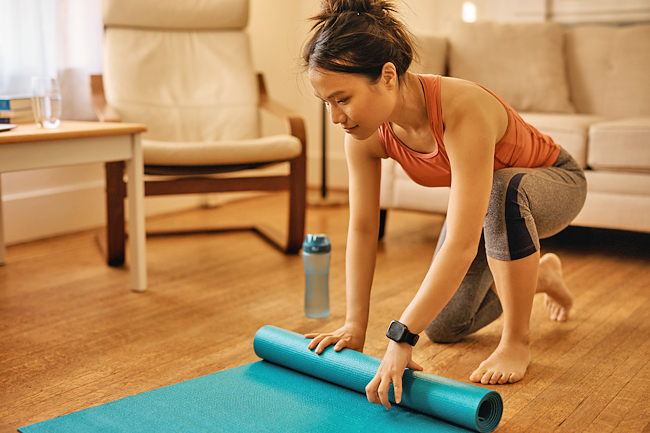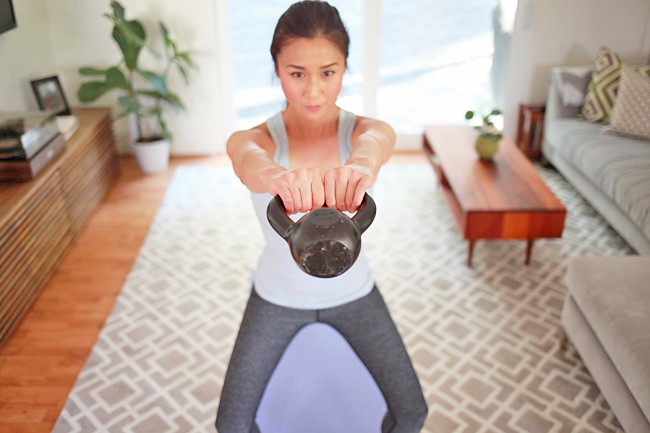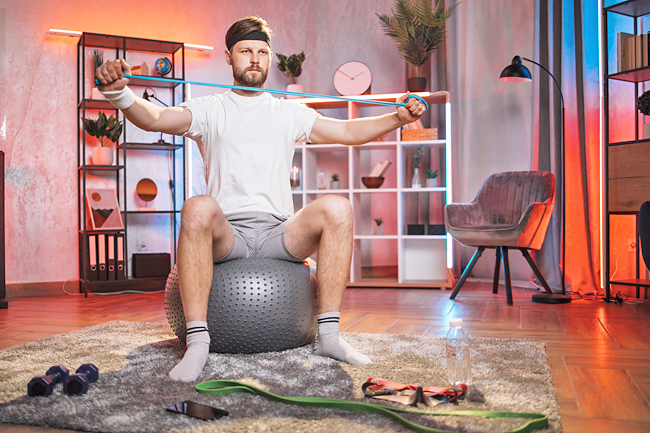Rosa Cartagena
THE WASHINGTON POST – You don’t need a tricked-out finished basement or even a separate room to create a functional and adaptable exercise space at home.
In fact, you don’t need much more than an underused corner.
To figure out if you have enough space, DC personal trainer Bianca Russo suggests standing in place, raising your arms and turning in a complete circle. If you’ve got enough clearance to do that, you can have a home gym.
Working out under your own roof has unique advantages, too. “There’s an attraction to having less barriers to entry and (not) having to leave your home (or) pay for a gym membership,” said personal trainer in Philadelphia Anna Claire Loper.
She aims to help “everyone in every body”, including her clients with disabilities feel comfortable getting fit. “Being home really creates a safer space.”
Even if you only have a patch of square footage to spare, read on for advice from Russo, Loper and other fitness experts on how to turn it into a real workout spot, using equipment that can be easily stowed out of the way.



1. MATS
If you live in a multi-family building or your workout space is on an upper level of your home, consider padding the floor to keep from antagonising whoever’s downstairs.
Russo suggested using a foam, puzzle-style floor mat. It will cover more area than a standard yoga mat and you can build onto it piece by piece.
“And, you know, it doesn’t get in your way, it doesn’t flop up,” said Russo, who specialises in training people of all body sizes.
Yoga mats, though, are useful for plenty of other reasons. Within the confines of a standard mat (typically about six feet long and two feet wide) you can get your heart rate up and build strength.
“There’s a lot that you can do in between those four corners,” said owner of Haus Yoga in DC Haley Richers. In her sessions, she amps up traditional positions with leg lifts and plank variations for strength building.
For cardio, she added mountain climbers in fast reps.
“Those full body moves help maximise your time, you’re hitting a bunch of big muscle groups,” she explained.
Yoga blocks are another essential at-home tool for balance support and as a “sweat device”, said Richers, because “a block will feel like 50 pounds after a little while holding it over your head”.
DC-based Mimi Rieger Yoga Mimi Rieger also suggests incorporating a bolster, which added support for restorative yoga sessions and, when you’re not mid-flow, can be used for your office chair. “It just helps you sit up taller,” she said.
2. THE MULTI-PURPOSE SYSTEM
One space-saving tool that fitness experts rave about is the TRX suspension trainer, which can be used for cardio, strength-building and interval training and then get tucked away into the included mesh bag.
Created by a former Navy SEAL, the TRX system features a set of bands with handles. The bands connect to an anchor point that allows you to leverage your body weight for hundreds of exercises, from chest presses and planks to squats and lunges.
“You can do push-ups and pull-ups and tricep and bicep work, you can really do a full body workout with a TRX,” said a trainer in Vancouver and author of Big Fit Girl: Embrace the Body You Have Louise Green. She noted that people with larger bodies who struggle with getting up and down can use the TRX to accomplish exercises usually done on the ground, such as rows and squats.
3. RESISTANCE BANDS
Resistance bands are crowd-pleasers, too. The experts we interviewed cited them frequently as a compact and affordable tool that anyone can use just about anywhere to build strength.
Bands come in different weights to offer more or less resistance, and you can adjust them as needed. Some have handles; others called mini bands come in a loop.
Loop bands are useful “for lower body movements, upper body movements, and for both push and pull movements”, said Loper. “It’s a super versatile piece of equipment and it’s very inexpensive.”
4. FREE WEIGHTS
If you’re looking to build muscles, you’ll also want a set of weights to complete your workout space. Some trainers swear by dumbbells, others by kettlebells or barbells, but it comes down to personal preference and lifting experience.
Dumbbells are standard home-gym fare and a beginner’s set typically includes five pounds, eight pounds and 12 pounds. Use them for common exercises such as dead lifts, curls and chest presses. Russo points her clients to this set that comes with a stand.
Kettlebells can be a bit more affordable and compact. With just one kettlebell, you can hit multiple levels of strength and conditioning. “You could have an entire programme with like three days or five days a week, and each time using the same kettlebells do something different,” said Loper.
Though kettlebells are great for basic exercises such as dead lifts and lunges, experienced users can move into “ballistic skills” which require an advanced level of control for fast-paced movements called the swing, the clean and the snatch.
5. OTHER MUST-HAVES
For DC trainer Errick McAdams, the other small necessities for home gyms are a jump rope for quick cardio, a pull-up bar for advanced clients, and a step-up, a box that can be used for both stair and seated exercises. The box also grants support for incline push-ups, tricep dips and seated oblique twists, among other moves.
Step-ups are highly effective for conditioning and cardio, and only occupy one square foot.
Russo recommended foam balance pads from Airex and exercise balls for clients seeking balance exercises and core stabilisation. Though exercise balls are rather bulky, she points out that they can double as office chairs.
Or, try a creative storage solution like a hammock designed specifically to keep the ball up and out of the way.




